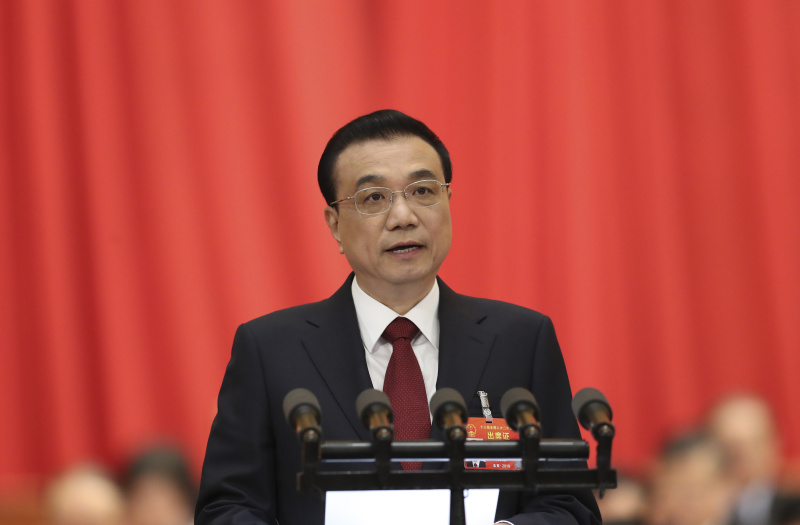(单词翻译:单击)
正文文本
Premier Li Keqiang announced the projected growth target while delivering the government's work report to the National People's Congress, China's top legislature, which opened its second session on Tuesday morning at the Great Hall of the People in Beijing.
"Our main forecast of economic growth targets for this year are a GDP growth of 6 to 6.5 percent, creating over 11 million new urban jobs, a surveyed urban unemployment rate of around 5.5 percent, a registered urban unemployment rate within 4.5 percent, and a consumer price index increase of around 3 percent."
Last year, China's economy grew 6.6 percent, above the official target but lower than the 6.8-percent growth registered in 2017. This comes as the Chinese government has chosen to shift its growth model from an investment-and-export-driven one toward a more sustainable style that draws strength from consumption, services and innovation.
In a bid to strengthen a more sustainable growth model, authorities have announced plans to increase value-added tax reforms. The government will reduce the current value-added tax rate of 16 percent for manufacturing and other industries to 13 percent. Tax rates in the transportation, construction, and other industries will be reduced from 10 percent to 9 percent.
Supporting measures, such as increased tax deductions for producer and consumer services, will be brought in to ensure tax burdens across all industries do not go up.
"We will introduce general benefit and structural tax cuts, focusing primarily on reducing tax burdens on the manufacturing sector and on small and micro businesses. We will reduce the tax burdens and social insurance contributions of enterprises by nearly 2 trillion Yuan this year."

The country is also planning to upgrade traditional industries and speed up the growth of emerging sectors. Premier Li Keqiang says more is going to be done to bolster innovation, while integrating the development of advanced manufacturing and modernized services.
"We will increase support for basic research and application-oriented basic research, step up original innovation, and work harder to achieve breakthroughs in core technologies in key fields. We will build enterprise-led mechanisms for bringing together firms, universities, and research institutes to engage in innovation. Innovation cooperation with other countries will be expanded."
The government will also strengthen intellectual property rights protection across the board, toughen the fines for IPR offenders, while promoting the goal of creating more Chinese-developed inventions and their industrial application.
Meanwhile, authorities say they intend to do more to attract foreign investment this year. The government is going to relax market access and shorten the negative list for foreign investment, which should mean more access to foreign investment.
"We will continue to implement measures for reform and opening-up for financial and other industries, and perfect policies for the further opening of the bond market. We will construct a fair market environment that treats domestic and foreign investment enterprises equally and without discrimination, with fair competition. We will also strengthen protection for the legitimate rights and interests of foreign entrepreneurs."
Authorities have also laid out a new fiscal deficit target of 2.76 trillion yuan, or 2.8 percent of GDP. This is up slightly from the 2.6 percent of GDP the deficit rose last year.
Total government spending is budgeted at over 23 trillion yuan, up by 6.5 percent from last year. The Premier says the increase in government spending is being done to stabilize economic growth.
The government also intends to expand investment, while accelerating a number of key projects. Some 800 billion yuan will be invested in railway construction, as well as 1.8 trillion yuan in road construction and waterway projects this year.
参考译文
星期二上午,中国最高立法机关全国人民代表大会第二次会议在北京人民大会堂开幕,国务院总理李克强作政府工作报告,提出今年的经济增长目标。
“今年经济社会发展的主要预期目标是:国内生产总值增长6%-6.5%;城镇新增就业1100万人以上,城镇调查失业率5.5%左右,城镇登记失业率4.5%以内;居民消费价格涨幅3%左右。”
去年,中国经济增长6.6%,达到官方预期,但低于2017年6.8%的增速。这是由于政府转变经济增长模式,即从依靠投资和出口驱动转变为更加可持续发展的增长模式,即转向消费、服务和创新。
为实现更加可持续的发展模式,政府将深化增值税改革,将制造业等行业现行16%的税率降至13%,将交通运输业、建筑业等行业现行10%的税率降至9%。
同时,通过采取对生产、生活性服务业增加税收抵扣等配套措施,确保所有行业税负只减不增。
“普惠性减税与结构性减税并举,重点降低制造业和小微企业税收负担。全年减轻企业税收和社保缴费负担近2万亿元。”
政府还计划对传统产业进行升级,推动新兴产业发展。国务院总理李克强表示,将先进制造业和现代化服务业融合发展,加大创新力度。
“加大基础研究和应用基础研究支持力度,强化原始创新,加强关键核心技术攻关。健全以企业为主体的产学研一体化创新机制。扩大国际创新合作。”
政府还将全面加强知识产权保护,健全知识产权侵权惩罚性赔偿制度,促进发明创造和转化运用。
同时,今年政府将加大吸引外资力度。进一步放宽市场准入,缩减外资准入负面清单,允许更多领域实行外资独资经营。
“落实金融等行业改革开放举措,完善债券市场开放政策。营造内外资企业一视同仁、公平竞争的公正市场环境。加强外商合法权益保护。”
政府还制定了2.76万亿元的财政赤字新目标,占国内生产总值的2.8%。较去年2.6%的占比有所上涨。
今年财政支出超过23万亿元,增长6.5%。李克强总理表示,增加政府支出旨在稳定经济增长。
政府还将扩大投资,加快实施一批重点项目。完成铁路投资8000亿元、公路水运投资1.8万亿元。
重点讲解
重点讲解:
1. bring in (政府或组织)推行,采用(新的法律或制度);
Some cities such as Berlin bring in for-profit companies 'to operate the system.
也有一些城市,比如柏林,引入了营利性机构进行系统运营。
4. speed up (使)(某一过程或活动)加快;
It also comes with some performance improvements that speed up the job processing.
它还对性能进行了提升,以加快工作处理的速度。
3. step up 增加(数量等);提高(速度、强度等);
We should further promote dialogue and reconciliation and step up the solution of regional hot issues.
我们要进一步促进对话与和解,推动地区热点问题的解决。
4. across the board 影响全体地;全面地;
There will be a wage increase of20 dollars a week across the board.
全体员工每周工资将增加20美元。


